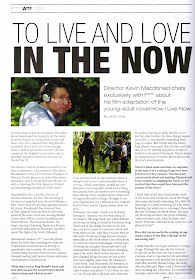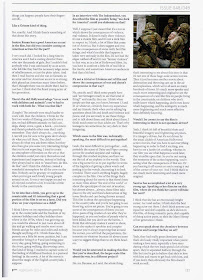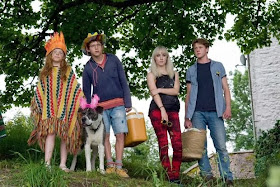ROBOCOP
Director: José PadilhaCast: Joel Kinnaman, Gary Oldman, Michael Keaton, Samuel L. Jackson, Abbie Cornish, Jackie Earle Haley, Michael K. Williams, Jay Baruchel, Jennifer Ehle, Marianne Jean-Baptiste
Genre: Action, Sci-Fi
Run Time: 121 mins
Opens: 30 January 2014
Rating: PG13 (Violence & Brief Coarse Language)
It’s been 27 years since Peter Weller stepped out of a police cruiser and into pop culture iconography in Paul Verhoeven’s now-classic RoboCop. A violent, biting and darkly comic piece of sci-fi action satire, the film had a lot to say about the state of late-80s America and cleverly hid all that beneath its franchise-ready action hero. The 1987 film spawned two sequels, various incarnations on TV both live-action and animated, comic book crossovers (Robocop vs. The Terminator!), video games, toys and the like, and after years in development hell, Alex Murphy returns to the big screen in this reboot from director José Padilha.
It is the near future and robots manufactured by conglomerate OmniCorp are helping to keep the peace abroad, but are still banned from enforcing the law on domestic streets by a bill passed by the U.S. senate. OmniCorp CEO Raymond Sellars (Keaton) enlists the help of his chief scientist Dr. Dennett Norton (Oldman) to create a robot-human hybrid to convince Americans of the viability of a robotic police force. Dr. Norton’s guinea pig arrives in the form of Detroit cop Alex Murphy (Kinnaman), near-death after being caught in a car bombing. Murphy’s wife Clara (Cornish) and son David (John Paul Ruttan) are uneasy about his new form, while fiery political commentator and TV host Pat Novak (Jackson) champions the arrival of Robocop onto the scene. Murphy is now a souped-up crime-fighter, a shiny commercial product, a poster boy – but is he still a human being under all of that?

Change is painful. We at F*** are geeks and fans and we totally acknowledge that and this review is going to be filled with comparisons to the original RoboCop. The RoboCop reboot has been met with outright hostility from the moment of its announcement, many holding Verhoeven’s film sacrosanct. The internet erupted with cries of “I won’t buy that for a dollar”. Robocop’s matte-black suit was revealed, and what followed was possibly the largest backlash against a cosmetic change to a character since Michael Bay put flames on Optimus Prime. And what’s up with that ungloved hand? Suffice it to say that we definitely had our doubts going into this but the end result was surprisingly decent.
Yes, we’ve all heard that remakes and sequels are the only things that get made these days, but a remake/sequel doesn’t have to be bad and first of all needs to make a good case for its existence. RoboCop 2014 does that to a degree. There’s still satire, the targets are different and it’s heavy-handed, but it’s still there. Most of it is provided in the form of Samuel L. Jackson’s future-Glenn Beck who proclaims America as “robophobic” and whose show The Novak Element helps establish and frame the world of the film. An opening scene is set in “sunny Tehran” where suicide bombers protest the presence of American OmniCorp robo-troops – uncomfortable, questionable in terms of taste, but more daring than we expected from this movie. Greedy mega-corporations take the most hits – which is more than a little ironic seeing as this comes from Columbia Pictures, a Sony entertainment company.
Joshua Zetumer’s screenplay is well-written, there’s forward momentum to the story and it doesn’t drag its feet, though some references to the original movie are somewhat awkwardly shoehorned in. The story differs in quite a number of ways from the 1987 film. The PG-13 rating does mean that the brutality is less in-your-face, but this does not cripple the film and there are several very impactful scenes of body horror. However, it is disappointing that the character of Anne Lewis, the tough cop who was also the primary refuge for Murphy’s humanity after his reconstruction, has been dropped. Robocop is built in a lab in China and his new, sleek Iron-Bat-Dredd look can’t compare with the charm of the shiny, bulky Detroit steel designed and built by Rob Bottin for the 1987 picture. The camera also has a rather annoying tendency to swoop 360 degrees around characters whenever they’re having a conversation, in addition to going all shaky-cam during action sequences.
This is Joel Kinnaman’s first major lead role, and he’s not bad, but this reviewer did miss the distinct physicality and vocal performance Peter Weller brought so memorably to the part of Alex Murphy. The weakest part of the film is probably the relationship between Murphy and his wife, seeing as how Kinnaman and Abbie Cornish have next to no chemistry so the audience can’t feel the loss and hurt of separation and of Murphy possibly losing his humanity as deeply as would have been possible. A scene early in the film where they’re about to make love but stop short because, well, PG-13 is markedly rote and passionless. This take goes into the impact that Murphy’s transformation has on his family in greater detail and a good chunk of the movie is spent contemplating philosophical issues far deeper than the title RoboCop would suggest, but to mixed results, seeing as Murphy’s lack of closure in the 1987 film was a heart breaking driving force of the narrative and he actually gets to see Clara and David again here.
In the midst of the jeremiad of gripes stalwart RoboCop fans had about this reboot, one would occasionally hear “well, that supporting cast sounds awesome” – and that is wholly accurate. Gary Oldman lends the film heart and credibility, completely believable as a well-meaning but ultimately flawed scientist and in some ways he’s even more of a “wife” to Murphy than Clara is. Michael Keaton, replacing the initially-cast Hugh Laurie, is oh so deliciously slimy as corporate creep Raymond Sellars. Samuel L. Jackson brings the bluster and the posturing, perfectly cast as a larger-than-life, hyperbole-prone TV personality. Jackie Earle Haley entertains as well as the mercenary who’s put in charge of training Robocop and is none too fond of Murphy, dubbing him “tin man”. Haley has the remarkable ability to raise one eyebrow and form wrinkles on only one side of his forehead; he makes this face a lot.

Nothing’s going to replace one of the best films of 1987 but let’s face it, a carefully-handled update might win the original a new generation of fans and it’s not like it’s going to wipe Verhoeven’s movie from existence. Director José Padilha has put together a remake that’s slick, sharp and yes, a little sanitized, but not completely de-fanged nor pointless and soulless. This ends up trumping 2012’s Total Recall, also a remake of a Verhoeven sci-fi action flick. The prime directive here is to entertain, and that, RebootCop does. And hearing Basil Poledouris' original theme tune over the opening titles will probably put a smile on your face even if you were dead-set against this remake.
Summary: It won’t be easy for die-hard fans of the original to warm up to this remake, but Padilha’s RoboCop is a surprisingly solid outing, benefitting from several clever story changes and a killer supporting cast.
RATING: 3.5 out of 5 Stars
Jedd Jong

















































